* Plants # 6, #8 and #9 have been in flower since 4-25-15 and will be harvested around 7-4-15.
** The screen limits vertical growth to 10 inches.
March 14th: Week 1 (Vegetation)
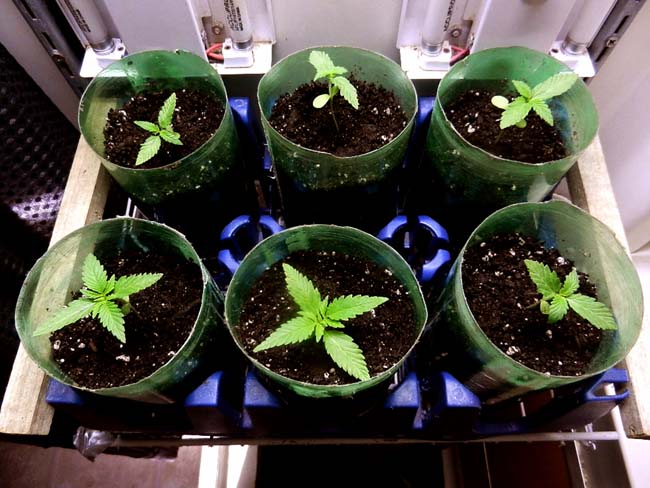
I
was gifted 6 two weeks old rooted seedlings that had been germinated from seeds of an outdoor
plant of an unknown cannabis species. All the seeds had been planted together
in a small container and were about to outgrow their accommodations as each was 4 inches tall.
I was
able to separate them and planted each 2 inches deep in its own topless 1.5 liter plastic 7 UP bottle.
Each bottle had been pre-filled with 450 grams of Happy Frog organic potting soil moistened with 1 cup of RO H2O
and left to drain for 6 hours. This potting soil was used in Grow 11 where
it performed admirably. Its all natural ingredients, including soil bacteria,
produce a 'living' soil that provides all that the plants need in the way of nutrition during their entire
vegetative period. Just add water.
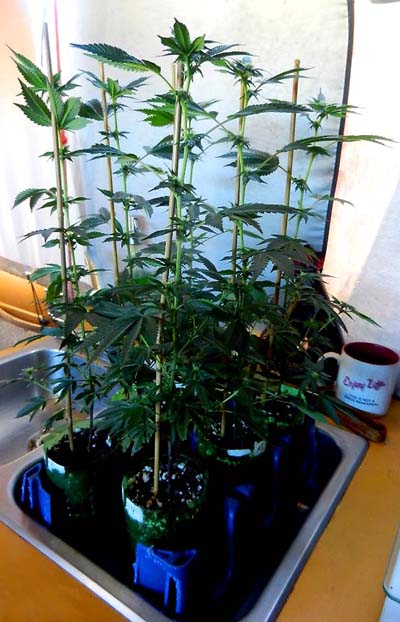
Because these were not clones there is no guarantee as to what sex they may
be. In order to determine that, all the seedlings need to be grown through
the first two weeks of flowering. By that time the difference in male vs.
female flowers will be obvious and the males can then be eliminated.
These containers were used in Grow 4 to vegetate and flower 6 healthy Blue Dream clones
which eventually reached 17" tall. The grocery shelf soda bottle carton makes
for a simple way to keep the tall bottles from tipping over and for safe
transport if necessary.
The close spacing forces the plants to grow tall rather than to bush out
giving them longer stems with more nodes (future branches).
They will spend the first 6 - 8 weeks under 84 watts of T5 fluorescent
lighting 18 hours per day in the original vegetation chamber and then will be transplanted
into 1 gallon containers and transferred to the flowering chamber.
Since they will be over 12 inches tall at that point the plants will be placed under the
SCROG screen and each main stem will be bent over to continue growing on the horizontal
under the screen rather than vertically through it. This will allow each flowering node along that stem to develop maximally
with equal exposure under the overhead light.
At the point of the bend the stem will be cinched to the screen to keep it
from being uprooted as it is being trained to grow across the screen. Once it reaches
the edge of the screen the stem will be pinched tightly back at the bend until
it goes limp. This is called supercropping
and the plant's repair of the minor damage will result in a stronger stem and more budding sites. Since all bud sites
are now on the horizontal each bud will resume vertical development.
I am really looking forward to this grow - the idea of a mystery plant intrigues
me. I wonder what sorts of insights from my previous grows I will be able
to bring to bear on the unraveling of the mystery? On first impression they
remind me of some bag seed I germinated in 1969 ... generic Mexican with
that beautiful lime green coloration.
I was able to view (and sample) the flower/bud that the seeds came from.
It was about 3" long and 2" wide shaped like a pine cone. The smoke
was smooth and uplifting rather than sedative. It had the characteristics
of a sativa dominant hybrid.
3-18:
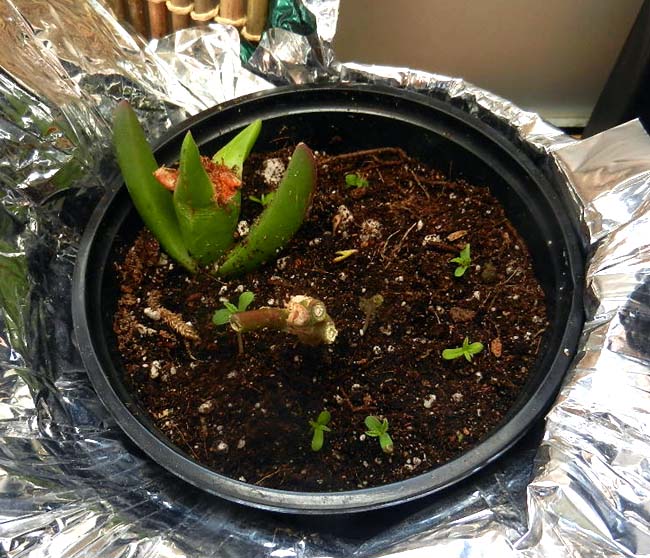
This is the original 6" container that the first set of seedlings came from
... this morning I found some more recent arrivals clustered closely together and was able
to successfully relocate them further apart. Once viability is assured they
will be thinned back to to keep within the total overall 12 immature plant
maximum and transplanted to their own 1.5 liter soda bottles.
After
the seedlings are sexed the females will be transplanted to 1 gallon pots
to continue flowering. The ratio of male to female seeds is about 50/50 so
I am hoping for at least 6 females. If there should be more my most recent
medical cannabis authorization is for 15 mature (i.e. flowering) plants although
the shelf can only handle 8-9 one gallon pots.
The other option is to leave the females in the 1.5 liter bottles and grow them
as a SOG (Sea of Green) which resembles a closely spaced pine tree plantation.
The plant is limited to a central leader with a single large terminal flower
(cola). The plastic 16" x 22" tub in the flowering chamber can hold
two of the 10" x 14" soda bottle crate/carriers so it could accommodate as many as 12
plants at a time.
March 21st: Week 2 (Vegetation)
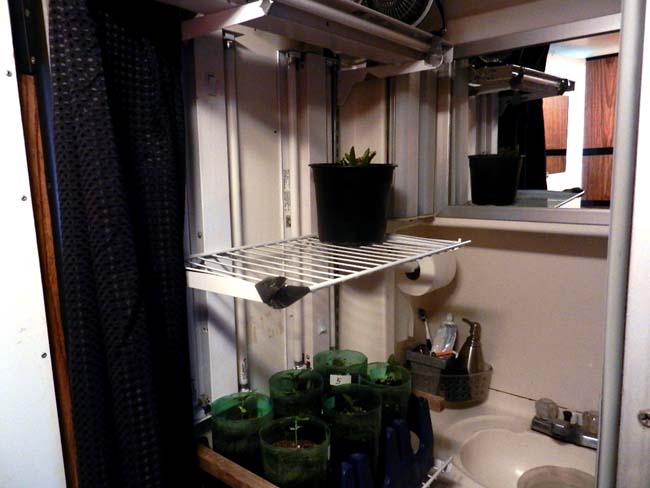
Added a second shelf for the next group of seedlings which have grown another
1/2 inch as did the first set of seedlings. Also added a small 4" fan above
the light to help disperse what little heat there is from this 3 fixture
setup.
Originally the soda bottles weighed around 674 grams wet (450 dry) and now
they are down to 550 grams. The moisture probe still shows about 50% as well
so I will continue to monitor but don't expect to have to water until later
in the week. The second set of seedlings are doing well but won't be ready
to transplant until next Saturday when they have two developed nodes not counting the seed leaves.
3-23: The first set of plants (in the bottles) were given 1/2 cup RO H
2O
each today bringing the containers up to 630 grams (wet). Since this is an
organic living soil no nutrients need to be added during the vegetation stage.
All have 3 nodes (branches) and one has four. The internodes (spaces on the
stems between sets of branches) are quite close together like an indica so
the plants might be a cross (hybrid) ) between an indica and a sativa.
At first the stems stretched quite a bit to the point where I was beginning
to get concerned but now it appears that they were trying to clear the rims
of the containers before producing the third node. The second set won't be
planted as deeply (2") in the container as they are filled with 500 grams
(dry) rather than the 450 previously. That will bring the soil level to within 1" of the rim.
This second set of bottles was given 1/2 cup RO H
2O
each to activate the soil bacteria prior to the transplanting bringing them to 650 grams (wet) each.
The pot with the second set was given a total of 1/2 cup RO H
2O which will be
enough moisture to get them through to the end of the week when they will
be transplanted to their own bottles. They have already started on their
second nodes.
March 28th: Week 3 (Vegetation)
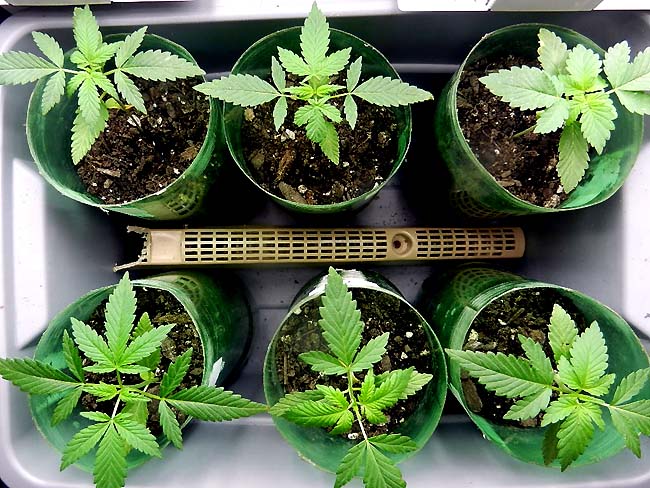
All of the first set of seedlings are coming along beautifully having put
on another 1/2" this past week. The soda bottles still have plenty of moisture
and so won't be watered again until mid-week at the earliest.
I had guessed earlier that this mystery strain was a hybrid ... possible
proof is in the contrast between apparent indica phenotypes (upper right
hand corner [#2] and second picture lower left corner [#8]) with their fat leaves and
rounded tips versus the others with thinner, more pointy leaves characteristic
of sativas. Since there are only two such indica phenotypes out of the twelve
a further guess would be that this strain is a sativa dominant hybrid with
perhaps a 80/20 ratio.
The second set of six were transplanted into
the 1.5 liter soda bottles today and placed on the top shelf. The average
wet weight of the bottles is 620 grams. Dry weight was 500 grams. It's obvious
that both sets of plants need at least six weeks of vegetation or more to
reach the flowering stage height (12-14"). Not all of that can be accomplished
under the T5 fluorescent lighting due to shelf height limitations.
Now I think it best to transfer the plants to the flowering chamber as soon
as Grow 11 has been harvested and finished being hung dried. Then the photoperiod will
be reset to 18/6 to keep them in the vegetative state where the more powerful LED light will help them achieve
the needed height more quickly than in the vegetation chamber.
Rather than find another soda crate and fabricate handles I just purchased
a 10" x 14" rubber tub with built in handles. The original soda crate will
remain on the top shelf of the vegetation chamber for the newest seedling
as it allows some of the overhead light to penetrate through it and the shelf
to the plants below. Ultimately it needs to be replaced by a wire tote though
for the best penetration. Two more tubs will be purchased
for the flowering chamber as it is easier to handle two sets of six plants
each than a tub with all 12 plants.
4-3: The first set of seedlings were each given 1/2 cup of spring water (out
of RO) today bringing the wet weight to approximately 580 grams. The second
set were also given 1/2 cup of spring water and the containers were equalized
at 640 grams (this set's dry weight is 500 grams whereas the first set was
50 grams lighter).
April 4th: Week 4 (Vegetation)
Towards the end of last week the original set of plants showed some dramatic
growth as all the plants put on an additional node or two and are 3.5" tall.
The roots are just starting to show up at the edges of the containers.
One
plant though, #5 (on the right), is even larger at 4" tall and 5" wide ...
I've been told that male plants get an earlier start so that they will tower
over the females when they flower. In this case it is not yet clear whether
this is a phenotype or sexual difference. It will definitely be tracked to
see if size is really an early indicator.
The second set of seedlings are doing equally well and are now at 1.5 inches having also put on 1/2 inch.
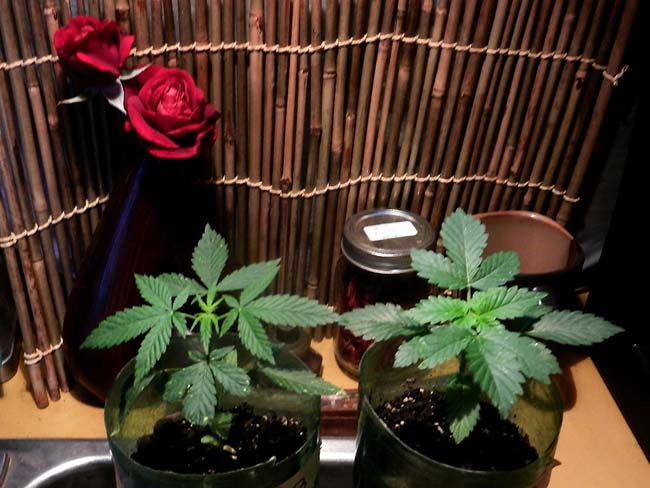
Here again are the two different phenotypes that had been discussed earlier.
The sativa dominant (#3) on the left and the much fatter and broader leafed
indica (#2) on the right. As previously explained these phenotypes (differences
within a strain) represent the two parent plants that were crossed to produce
the hybrid seed used for the current generation. If these two are both females
then they will produce medicine with noticeably different characteristics.
(Vegetation)
Mostly an uneventful week with the first set of plants putting on another
half inch. The second set though put on a full inch and are now up to 2.5
inches. Interestingly the second set are showing more roots at the edges
of the containers than the first and older set. I suspect it has to
do with closeness to the overhead bulb ... the first set have always been
further away and now have a shelf above them which almost completely blocks
their top light.
Not that that is necessarily bad in that I am trying to keep both sets short
and not too stretchy while they wait to be transferred to the flowering chamber
to finish out their vegetation.
All plants given 1/2 cup (112 grams) of RO H
2O.
April 18th: Week 6 (Vegetation)
All twelve plants transferred 4-14 to the flowering chamber
under LED at 25% power until they adapt. They will be grown under vegetative
conditions (18/6 photoperiod) for another couple of weeks until they become
sexually mature at which point the photoperiod will be
reduced to 12/12. About two weeks later the males will be identified and
discarded.
"Plants
normally mature around the forth week of vegetative growth because sex is
not genetically determined until the third week of growth."
Still concerned about the effect on the plants of having fans blowing directly
at them in such a closed space. I shut off the oscillating feature of the
14" tower fan (rear left) and pointed it alongside the plants where it will
blow against the reflective surface of the opposite wall and indirectly ventilate
the growing area.
All the plants are within 20-24" of the overhead light which is the ideal
spacing for young plants. They can grow to a height of 19" or to within 12"
of the light before they begin to suffer from light bleaching which impacts
growth and quality.
The plants need to be of a good size so that when flowered the females are
large enough to fill the chamber. If flowered too early in order to sex the
plants and discard the males the females will remain underdeveloped and less
productive. Currently all the plants are under 6" tall ... they will
be started on the flowering cycle when they reach 12" tall in another couple
of weeks.
Since it isn't the best practice to transplant flowering plants and the chamber
doesn't have room for 12 one gallon pots the selected female plants will
be grown out in the 1.5 liter bottles as a SOG (Sea of Green) meaning that
the plants are spaced closely together limiting the plant to mostly vertical
development. This results in a single central leader and a large top bud
called a cola.
4-16: Both sets of plants watered today with RO H
2O
mixed with a light feeding of an organic fertilizer BioThrive Bloom. Happy
Frog potting soil suggests amendments after 4-6 weeks and since the plants
are being prepared for the flowering stage this will be there source of nutrients
just as it was for the previous grow.
The first (and oldest) set of plants was equalized at 600 grams (dry weight
450 grams) and the second at 650 (dry weight 500). This was done in
two stages - first a similar amount was added to each container and allowed
to sink in. After setting for 10 minutes the containers were weighed and additional
water/nutrients added to bring all in that set to an equal weight.
Reviewing past grows in the 1.5 liter bottles I noted their 5-6" plants were
already taking 1 full cup of nutrients twice a week. So starting with the
next feeding each will be given 1/2 cup initially and allowed to drain
for 10 minutes before being given the final 1/2 cup. This is to reduce the
amount that drips out of the container - these bottles don't have saucers
(yet?) and I will want to water them in place as they grow larger.
4-19: All containers were at or below their dry weight so they were each given 1 cup of RO H2O
with a light feeding of BioThrive Bloom in two stages to prevent excessive
dripping. The actual amount retained though was only about 150 grams
each or a little over 5 ounces. Perhaps the difference between the past and
the present grow is due to the greater water retention ability of the former
since they had been amended with 30% perlite.
Generally containers are watered to the point that they drip and then the
amount retained is measured. Since these plants will be watered in place
it is important to establish their retained amount level so that they are
not over watered.
4-22: All plants given 1 cup of RO H2O with a light feeding of
BioThrive Bloom and again only about 150 grams out of the 224 given was retained.
The plants have now been transitioned to the LED at full intensity and all
appear to be thriving with well developed root systems.
April 25th: Week 7 (Vegetation)
All plants given 1 cup of RO H
2O with a light feeding of BioThrive
Bloom. All were very droopy this morning with a few of the lowest branches
collapsed completely. Since the plants are only retaining 100 - 150 grams
each it will be necessary to begin watering every other day.
Plants growing about 2 inches per week now and will be ready to flip in two
weeks. These mystery plants are clearly an indica dominant hybrid - notice
the fat leaves and squat profile. Indicas stop their vertical growth as soon
as they enter the flowering stage so these need to grow a few more inches
so that I can reach under the canopy and between their main stems with the watering cup when they begin to
be watered in place.
After looking at the above picture I realized how crowded the flowering chamber
is going to become shortly. Operating on the theory that males plants are
taller and faster growing than females I identified the tallest plants within
each of the two groups as potential males.
They (#'s 3, 6, 7, 8, 9, 12) were relocated to the original
vegetation chamber where the photoperiod was increased to 12 hours of darkness
to trigger flowering. If I guessed correctly this will allow for an earlier
sexing and elimination of the males. Any that are female will get a head start
on flowering.
4-27:
All plants given 1 cup of RO H
2O
with a light feeding of BioThrive Bloom. The 6 that were in the flowering
chamber were completely drooped this morning and still haven't revived completely
4 hours later. Those larger plants, which were relocated to the vegetation
chamber, are doing just fine.
All of the plants had their
soil level adjusted to within 1 inch of the rim and all were equalized around
630 grams wet meaning their true dry weight is around 450 grams. They will
be allowed to dry down to 500 grams before rewatering if they don't droop
too much. I noticed that the previous grow (#5) in those bottles had dry
weights 50 grams lighter which was due to the 30% Perlite their potting mix
contained.
In the previous grow I learned not have the 14" oscillating fan blow directly
on the plants but they still need some agitation to stimulate branch growth.
So I mounted the fan so that it would blow gently across the top 1/3 of the
plants in the flowering chamber. It appears to be stimulating them to lift
up the previously drooping fan leaves. The fan is on the same timer as the
lights as it is not needed at night.
4-28: The plants in the flowering chamber were down near 500 grams this morning and were given 1/2 cup RO H
2O
to bring them back up to 600 grams which is where the other plants are. Perhaps
it is the extra 6 hours of light that is causing them to use more water?
All of the plants had the lowest 4 inches of their main stem stripped of foliage
.... the large fan leaves at that level were on weakened branches
which couldn't support them and were taking up energy better used further
up the main stem. Now each plant has just 4 strong nodes. As in all thinning
activity growth will slow down as the plants heal their wounds and then rebound
with vigor in about a week.
5-1:
All plants given 1/2 cup of RO H
2O
with a light feeding of BioThrive Bloom ... interestingly the closer their
weights dropped to 450 grams the more erect the plants became. Is it possible
that the have been over watered and that's why they droop? All plants were equalized at 575 grams.
The first 1/2 cup did not moisten the containers thoroughly as some immediately
ran down the sides where the soil had shrunken away. After the initial draining
(5-10 minutes) additional water/nutrients were added to 'top off' each container
at 575 grams. Subsequent testing with the moisture probe revealed the moisture
was equally distributed throughout the containers with no dry pockets.
Since they are still recovering from the pruning earlier in the week I expect
they will go for 4-5 days before needing to be watered again. By that time
the first set of plants will have been sexed with the females transferred
to larger containers.
May 2nd: Week 8 (Vegetation)
Well this was not expected and shoots that theory down ... the tallest of
all the plants, number 6, appears to be sprouting whitish yellow pistils
after being in the flowering stage for only 6 days! Unless it turns out to
be a hermaphrodite we have our first female plant. None of the other plants
in that set are showing signs of sex yet. [Later] I went back and reread the
original article that made that suggestion about height and discovered this previously overlooked disclaimer:
(Note: marijuana plants grown indoors under artificial light don't usually exhibit these tendencies).
5-3: The 6 plants under 18 hours of LED had all dropped below 450 grams and so were given RO H
2O
with a light feeding of BioThrive Bloom bringing their wet weight to 575
grams. The other 6 under 12 hours of CFL were still above 500 grams and will
be watered tomorrow. Still no signs of sex differentiation in the other plants
on that shelf.
5-4: The six plants under CFL were given RO H
2O and a light
feeding of BioThrive Bloom at 5 pm bringing their wet weight to 575 grams. A second
plant, #9, has revealed that it is female. So far no males or anything that
even resembles the male pollen sac. It's easy to confuse young stipules with
pistils ... until you remember that pistils always emerge in pairs. ... two
to each calyx.
5-5: The 6 plants under 18 hours of LED were given RO H
2O
with a light feeding of BioThrive Bloom bringing their wet weight to 575
grams.
5-6: It has been 11 days since the photoperiod was increased and yet
only two of the six plants have revealed their sex. Usually all 6500K lights
used for vegetation are swapped out for bulbs in the 3000K spectrum for the
flowering stage but I left the overhead T5. Thinking that might account for
the delayed flowering I swapped it out today for a lower spectrum bulb.
May 9th: Week 1 (Transition)
All plants were watered today with RO H
2O
and a light feeding of BioThrive Bloom bringing their wet weight to 560 grams.
Again I've noticed that this strain prefers drier conditions ...some actually
were well below the 450 gram mark and still showing signs of adequate turgor.
The three identified females (#6, #8 and #9) were transplanted to one gallon
nursery pots filled with Happy Frog potting soil and equalized around 1300
grams semi moist. They were then transferred to the flowering chamber which
had its photoperiod increased to 12 hours of darkness to simulate the lower
light levels during the late summer/early fall flowering stage. All plants
have now been switched to the flowering stage. The flowering chamber can
hold 8 of these 1 gallon pots.
All 3 plants remaining in the vegetation chamber, #'s 3,7 and 12, developed
pollen sacs and were eliminated.
5-10: Since the tallest female, #6, was already over 11" tall and reaching through the recently installed screen she was
super-cropped.
This is a technique to reduce height and redirect growth to the horizontal
under the screen by pinching the main stem until it flops over on its side.
In order to keep subsequent horizontal growth from pulling at and uprooting
the plant its stem was staked and tied to the edge of the pot with a soft
aluminum wire fence tie.
5-11:
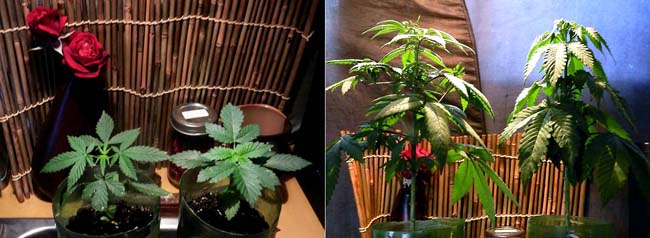
A month ago I had singled out these two plants (#'s 4 and 2) as examples
of the two very different phenotypes in this bunch of seeds. On the left
in each picture is the sativa phenotype with its open structure and thinner
and pointed leaves. On the right is the more indica dominant phenotype -
a squatty profile with rounder and broader leaves.
Another difference - both of the containers (in the right hand picture)
weigh around 400 grams. Notice that the sativa (#4) is erect and outstretched
whereas the indica (#2) appears to be drooping.
This held true for all the other indicas as well. Apparently their larger
leafed indicas transpire more moisture than the sativas. I am going to put
off watering the sativas until tomorrow to see how well they hold up.
Of the three females identified so far #9 is a sativa dominant and #'s 6
and 8 are indica dominant. The other six unsexed plants are equally divided
between the two. Only one of the three identified males was a sativa.
Plants #'s 1, 2 and 10 (unsexed indicas) were watered with RO H2O and a light feeding of BioThrive Bloom bringing their wet weight to 530 grams.
5-12: Plants #'s 4, 5 and 11 (unsexed sativas) were watered with RO H
2O
and a light feeding of BioThrive Bloom bringing their wet weight to 515 grams.
The initial 1/2 cup of nutrients only brought the containers up to 450 grams.
The second took them to 500 grams which seemed their limit even though the
soil was not equally moistened as seen from the outside.
The three females in the 1 gallon pots weighed around 1200 grams - down only 100 grams in 4 days with no sign of drooping.
All of the plants seemed to have recovered from last week's pruning of their
first three nodes and their large fan leaves. They appear to be exceptionally
healthy and vigorous. I've noticed that towards the end of the vegetative
period the plants begin to look a bit raggedy but as soon as they enter the
flowering stage they bounce back looking taller, slimmer and better defined
- sort of like early adolescents between the 7th and 9th grades.
Looking over the unsexed plants today I realized both #1 (indica) and #11
(sativa) now had pistils ... they were replanted into 1 gallon nursery pots and
equalized at 1300 grams. Now there are five identified females with the possibility
of several more.
5-14: Another of the unsexed sativas (#5) was showing pistils and was replanted
into a 1 gallon nursery pot equalized at 1300 grams. I now have 6 females.
2 pm: Plant #4 (another sativa) appears to be a female as well. It
will be watched for another couple of days and if it is we have our first
mother plant! Striking clones from a mother plant is the only part of the
growing process that I have not experienced yet.
5-15: Good News!
Plant #4 is definitely a female - sativa dominant. She was repotted
into a 1 gallon container and equalized at 1300 grams of Happy Frog organic
potting soil. She will remain in the vegetation chamber in an 18/6 photoperiod
under 84 watts of CFL (20" T5 fixtures) including 56 watts of vertical side
lighting in order to reverse flowering and force the plant to reenter the
vegetative state.
In order to lower her height and increase her bushiness (from which to strike
clones) she was topped i.e. had her central leader removed several nodes
down leaving two opposing stalks which will grow into their own central leaders.
As the other branches lengthen they too will be topped and their removed
central leaders will be raised as clones.
The other 2 unsexed plants showed definite signs of becoming male so they were discarded.
None of the female plants were drooping so I will let them go another day before watering.
May 16th: Week 2 (Transition)
This grow cycle began with 12 mystery seeds raised from seedlings through
almost 2 months of vegetation and now there are 7 plants remaining - all
female and well launched into the flowering stage except for the mother plant.
They have been arranged in two parallel rows of 3 plants each to best take
advantage of the narrow footprint under the offset overhead LED fixture.
The area of consistent light intensity as measured by a light meter is outlined
in black electrician's tape. At this stage it is hard to envision the entire
screen covered in flowers but that is exactly what happens in this style
of growing called a SCROG or
SCreen Of Green.
Checked all of the females today to see if they needed watering and found
all containers around 1100 grams with no signs of drooping or curling leaves
- all erect and extending upwards. So the dry weight baseline has been
reduced downwards and will now be set near 1000 grams.
In the previous grow the pots were originally equalized at 1300 grams moist and were taking 2 cups of RO H
2O
plus nutrients every third day at this stage bringing their wet weight to
1450 grams which would indicate their actual dry weights were around 1000 grams.
Since the plants, now under the screen, will be watered in place it is very
important to get a sense of their needs without being able to weigh them
.
5-19: All pots near 1000 grams with no sign of drooping. I am willing
to let them go without watering as long as they can but I suspect they will
be drooping by tomorrow. Two more plants have now reached the screen and have been supercropped.
5-20: All flowering plants retained 1 cup of RO H
2O
with a light feeding of Biothrive Bloom bringing the wet weight of the containers
to approximately 1200 grams. The containers needed to be watered 3 x with
1/2 cup each time as they would drip excessively between waterings. 1200
grams seemed to be the maximum amount they would absorb so that appears to be the stable weight point.
Even though three of the plants were an inch short of the screen all remaining plants were
supercropped this morning. In doing so however plant #8's stem was accidentally broken on one
side but it was successfully propped up and is expected to recover. As long
as it is not a complete break the plant can recover by directing additional
resources to the injured area resulting in a knot at the break which strengthens
the branch.
The previously supercropped female, #6, is doing well and has now has 4 additional
nodes/flowers exposed to the overhead light. As the flowers grow the stem
will be advanced horizontally to the left, over several more squares, giving
each flower its own opening. This horizontal exposure forces each node to
become its own primary terminal stalk or cola. Colas are larger than what
the node would have been as a side or secondary bud on the main stalk under
the canopy.
At center right the bend in the stem, made 10 days ago when it was originally
supercropped, is healing and has started to form a knot.
May 23rd: Week 3 (Flowering)
Began LST (Low Stress Training) today by anchoring the stems to the edges
of the pots and then using another aluminum wire tie opposite the anchor
to pull the bent stem downward to form an arch exposing the side buds. The screen was removed
to give access to the plants and might not be replaced.
The drain pan was rotated 90 degrees so that the plants are arranged from
side to side rather than front to back. This will allow for the placement
of 2 - 3 more plants in the back row since I anticipate an overlap with grows
#13 and #14.
Currently each plant has at least 7 exposed nodes/flowers highlighted by
their yellow white centers. As the plants continue to stretch for another
two weeks more and more such nodes will be exposed.
All flowering plants retained 1 cup of RO H
2O
with a heavy (2 Tbls p/gal) feeding of Biothrive Bloom bringing the wet
weight of the containers to approximately 1200 grams. I've noticed that the
first couple of 1/2 cups just beads up on the surface and doesn't immediately
penetrate the soil. The soil was lightly scratched to assist in penetration.
5-26:
All flowering plants retained 1 cup of RO H
2O
with a heavy (2 Tbls p/gal) feeding of Biothrive Bloom bringing the wet
weight of the containers to approximately 1250 grams.
May 30th: Week 4 (Flowering)
Since three of the plants (6,8,9) are 2 weeks further along in flowering
than the other three (1,5,11) they are are about a week away from the dramatic
increase in flower/bud size that begins in the 5th week. For the time being
all plants are continuing to define and enlarge their yellow white flowers.
The largest bud (back row, center left) measures 3/4" x 3/4".
All flowering plants retained 1 cup of RO H
2O
with a heavy (2 Tbls p/gal) feeding of Biothrive Bloom bringing the wet
weight of the containers to approximately 1250 grams.
6-3:
All flowering plants retained approximately 3/4 cup of RO H
2O bringing
the wet weight of the containers to approximately 1200 grams. Only plain
water was used this time as I had discovered several burnt and discolored
leaves following the recent heavy feedings of Biothrive Bloom and suspected
a fertilizer buildup. The brochure that came with the LED unit specifically
advised using less water and nutrients than would be used under other forms
of high intensity lighting.
Trichomes Day 40
Accidents happen ... broke # 8's top stem yesterday at the same location
as a previously healed break. By this morning it was obviously losing moisture
and dying. Removed the stem with its bud and set them aside to dry.
Took the opportunity to make this somewhat fuzzy digital microscope image
of the developing trichomes (resin glands) ... appears to have well developed
stalks and the bulbs are large but still clear. As they fill with resin they
will turn cloudy and then amber with age.
This plant (along with #'s 6 and 9) was put into flowering April 25th so
technically today is day 40 of flowering. About 2 - 3 more weeks. The bud
is well developed but small with a strong fruity sweet aroma like a sativa.
Reminiscent of Grow #1 which was one of the Skunk crosses. Possibly might
be an early harvest like that one so trichomes will be checked again around
day 50.
June 6th: Flowering (Week 5)

Here
are the plants by number and age: 1, 5 and 11 in the front row and 6, 8 and
9 in the rear. Interestingly those in the rear row are not only older but
appear to be two different phenotypes as well. Plant #6 is much taller than
any of the others and both plants 8 and 9 are the smallest plants in this grow.
The plants in the front row and the mother plant (#4) all share an apparent third phenotype
which is more consistent both in size and branching. I hope they share the delightful
sativa fragrance that #8 has.
If these plants are sativas then they must be a hybrid cross because the
genetics for short plants (sativas can get 20' tall) comes from either indica
(most likely) or a third cannabis type, c. ruderalis which is an auto flowering
plant. In the present case ruderalis is not likely as these plants did
respond appropriately to the change in photoperiod and flowered normally.
All flowering plants retained 1 cup of RO H
2O
with a light (1 Tbls p/gal) feeding of Biothrive Bloom bringing the wet
weight of the containers to approximately 1200 grams.
6-7:
Plant #5 of the second set in
its 30th day of flowering. Notice the abundant pistils and size of the flowers
- the biggest of which is 1/2" x 1" tall. Tall narrow buds are another
indication of a sativa dominant strain.
Mother plant: It has been 16 days since
plant #4 was returned to vegetation after having been in flower for 6 days.
It still has the original few pistils which indicated it was a female but
there have not been any new pistils which indicates that the plant is no
longer growing calyxes.
But the pistils are still white and elongating and there is no new vegetative
growth. I have read that it could take as much as 4 weeks to revert. If it
hasn't still hasn't started revegetating by the time this grow is harvested
then it will be returned to the flowering chamber in a subsequent grow.
I was hoping to use this plant to learn the process of making clones but
so far it has been a lot of work for an unknown variety and it still hasn't
even reached the starting point. I'm inclined to just pick up 10 more Madman
OG (Grow 11) clones and hold back one as a mother plant.
That will have to wait until sometime in September when all the other grows
are completed because I want to start the clones in 1 gallon pots under LED
lighting from start to finish. I have concerns about the ability of root
bound plants grown in bottles to be successfully transplanted to larger containers.
The 1 gallon containers don't feel like the root ball has expanded to the
edges.
[Later]: I just read that rather than
flower all the plants grown from seed in order to sex them just top each
6 - 8" plant instead and root the cuttings in water. After they are rooted put them
under 12/12 until they show sex. That way the original plants are left in
vegetation to grow larger before the females are flowered. The sex is not
only determined earlier but the plants have been topped in the process guaranteeing
bushier growth.
6-9:
While working around the flowering plants this afternoon I got a whiff of
a beautifully sweet aroma - moving closer I realized the plants, at least
in the back row, were smelling like pineapple guava! I really wish I knew
their parentage.
All flowering plants retained 1 cup of RO H
2O
with a light (1 Tbls p/gal) feeding of Biothrive Bloom bringing the wet
weight of the containers to approximately 1200 grams.
June 13th: Flowering (Week 6)

Plants continue to develop their flowers but it is becoming apparent that
this strain is definitely not heavy flowering... like a typical sativa the
main colas are 3/4" x 2.5" but the side buds are still only 1/2" x 1". This
strain should not be trained to grow horizontally but rather left to grow
naturally - that is vertically with one or two main colas (terminal buds).
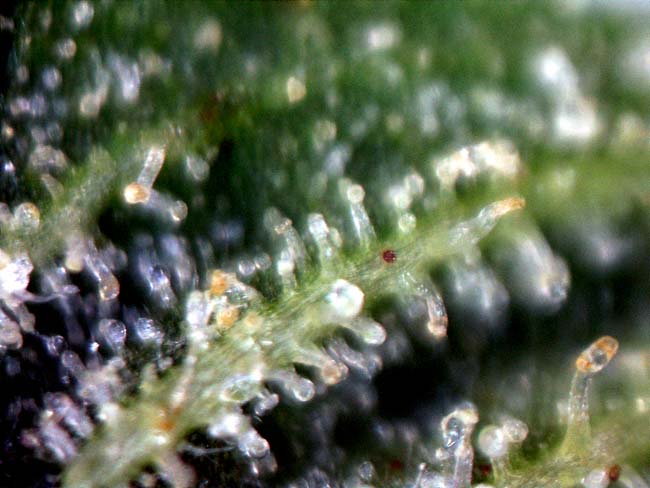
Trichomes Day 50 Plant #8
Another fuzzy microscope image ... having trouble adjusting the instrument
but it does show, in this clipping from plant #8, that the trichomes are still of mixed maturity with elongating
stalks (see
Trichome Chart)
but mostly clear to cloudy bulbs. Since these older plants (#6, 8 and 9)
will be ready to harvest in two weeks or so they will receive RO H
2O after today as a pre-harvest flush even though only organic fertilizer has been used.
Since these are sativas they will be allowed to mature through the 9th week or until a majority of the trichomes
have turned amber. It will help to moderate the sativa effects which can
be overstimulating if not offset with vigorous physical activity.
All flowering plants retained 1 cup of RO H
2O
with a light (1 Tbls p/gal) feeding of Biothrive Bloom bringing the wet
weight of the containers to approximately 1200 grams. The top bud on plant
#1 was partially severed last week and I have been trying to keep it propped
up. Apparently it hadn't formed enough scar tissue to hold the branch together.
It too was set aside to dry.
The broken bud from #8 which has been drying since 6/4 was sampled this
morning. There is no question but that it is a sativa. Some aroma and little
flavor at this point but definitely uplifting and stimulating ... found myself
having completed all my morning chores before I even realized it. That's
why sativas are used primarily during the day whereas indica is for strong
pain relief and night time relaxation.
6-16:
All flowering plants retained 1 cup of RO H
2O
bringing the wet
weight of the containers to approximately 1200 grams.
6-17:
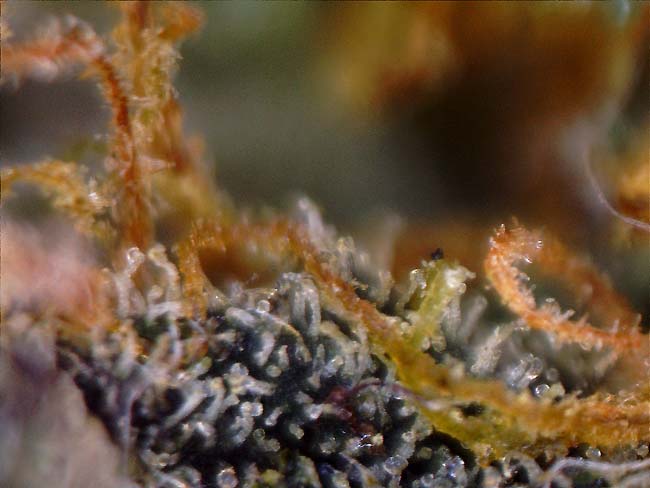
Trichomes Day 40 Plant #1
Here is a microscope image of a portion of the severed flower from plant
#1 after 4 days of drying. The retracted and shriveled pistils (yellow orange
- not in focus) are covered in trichomes as well as the rest of the flower.
The trichomes are well formed but mostly clear.
6-18:
All flowering plants retained 1 cup of RO H
2O bringing
the wet weight of the containers to approximately 1200 grams. The younger
plants (#1,5,11) also received a heavy feeding (2 Tbls p/gal) feeding of
Biothrive Bloom.
June 20th: Flowering (Week 7)
All plants continue to enlarge their flowers - the plants in the rear are
one to two weeks away from harvest. Plant # 11 (front row, right) has the
most incredible floral scent unlike the others which have a skunky overtone.
I'm hoping that the mother plant and its clones will have the same scent
since it resembles this plant in its sativa characteristics.
All flowering plants retained 1 cup of RO H
2O bringing
the wet weight of the containers to approximately 1200 grams. The younger
plants (#1,5,11) also received a heavy feeding (2 Tbls p/gal) feeding of
Biothrive Bloom.
Trichomes Day 57 Plant #8
Here is a much better image taken at the highest resolution
(2592 x 1944 pixels - 5 megabytes) and reduced to 650 x 488. The image has
been sharpened and had the contrast increased.
Normally this would be the earliest conventional harvest date but these trichomes,
though fully developed, are just beginning to fill with resin - they are
still mostly clear. Since I want to harvest at 100% cloudy stalks and 50%
amber bulbs it will definitely be another week or more.
The mother plant finally started revegetating
after almost 4 weeks. Needing to limit the height of the plant due to space
limitations twelve terminal shoots were removed ... as
before
this will effectively double the amount of subsequent terminals. This
will take several more weeks as any pruning of the plant stunts growth for
several weeks as the plants recover from loss of foliage. In the meantime
the plant is spending part of each day in the flowering chamber to take advantage
of the better light.
The tops were floated in a bowl filled with RO H
2O to see if they
would take root. Normally they would be dusted with a rooting hormone and
inserted into a rooting cube but I've been told that this method will work
as well especially since these were very short clones with little stem available
for insertion.
If this is successful the clones will be transplanted into rooting cubes
and kept in the vegetation chamber as all the other plants will have been
transferred to the flowering chamber by then following the completion of
this grow. When they are well rooted they will be transplanted to 1.5
liter plastic bottles. They will be grown vertically without any training
as a closely spaced SOG (Sea of Green).
6-21: The clones have been floating in water for 3 days now and show no signs
of wilting - all flowers are still upright. They are being checked daily
for any rooting activity.
7-7:
This
morning I noticed several of the floating clones had developed roots! Added
a minuscule amount of BioThrive Grow organic fertilizer and Dip 'N Grow rooting formula to the RO H
2O in the bowl
to encourage further growth. The rooted clones will remain floating in the
bowl for several more weeks until all of the plants in the vegetation chamber
have been transferred to the flowering chamber.
At that point the rooted clones will be transplanted into 1.5 liter bottles
and allowed to grow out for at least 60 days or until all of the plants in
the flowering chamber have been harvested.
7-9: Not sure if adding nutrients and rooting formula to the water in the
bowl was a good idea - this afternoon the cuttings were limp and appeared
to be waterlogged. Even if they don't survive the experiment was a success.
After the mother plant has vegetated for another month I will take more cuttings
and using the rooting formula will transplant them directly into 1.5 liter
bottles - bypassing the rooting in grow cubes stage.
=================================================================================
6-25: All flowering plants retained 1 cup of RO H
2O bringing
the wet weight of the containers to approximately 1200 grams.
June 27th: Flowering (Week 8)

The oldest plants (#'s 6,8 and 9) have been moved to the front row. Notice
how the larger fan leaves are fading and turning yellow as the plants, nearing
harvest, use up the last of the nutrients. In the last row (next to the oscillating
fan) are the two Berry Kush OG, the Pineapple Kush and the mother plant (#4)
from this grow.
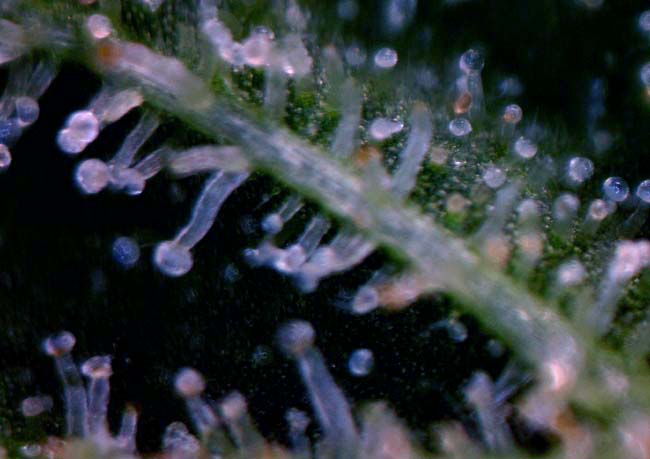 Trichomes Day 63 Plant #8
Trichomes Day 63 Plant #8
The older plants still need another week before they are ready to harvest.
All of the stalks are filling with resin and turning cloudy but only a few
of the bulbs have turned amber.
The oscillating fan was temporarily turned off to see if the plants do better
without it now that it is not needed to strengthen the branches. The inline
duct fan and the fans built into the LED unit should be enough to insure
adequate circulation along with the intermittent turbo exhaust fan. Again
there is this
concern about the desiccating effects of the oscillating fan
placed so close to the plants.
6-29:
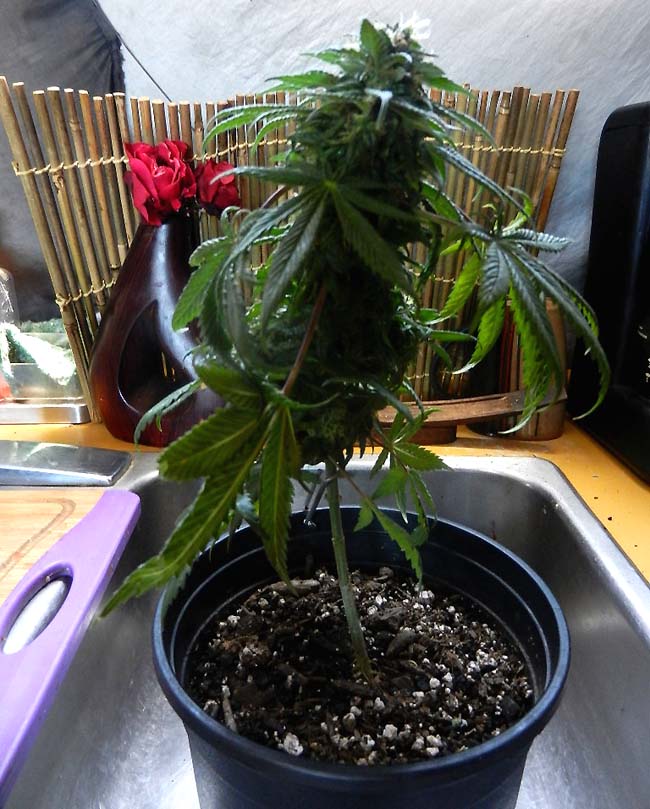
Plant #6 Day 67
Here is one of the almost ready to harvest plants being pulled back and
up into a vertical position to show how this strain should have been grown.
The central cola is 2" x 6" tall. Tall, narrow colas are a specific characteristic
of sativa dominant strains. This mystery strain has just enough indica in
the mix to keep the plants short.
7-1: Anticipating a heat spell all flowering plants were given 1 cup of RO H
2O bringing
the wet weight of the containers to approximately 1250 grams. The younger
plants (#1,5,11) also received a heavy feeding (2 Tbls p/gal) feeding of
Biothrive Bloom.
7-2:
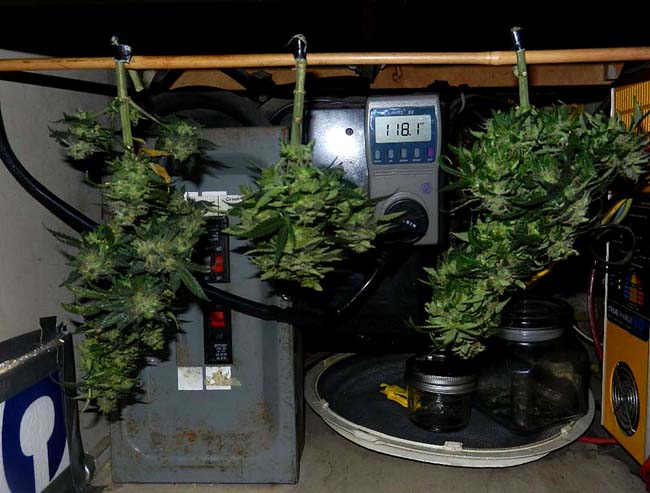 1st Harvest Plants #6,8,9
1st Harvest Plants #6,8,9
Harvested the oldest plants today (Day 70) for a total of 76 grams of rough
trim bud and 16 grams shake. Net weight after 10 days drying and final trim
will be between 1/2 to 3/4 ounce (14 - 21 grams). This is normally what I
can expect from a single plant vegetated for two months and reaching 16 -
18" before flowering. These plants were flowered early around 10" because
they had to be sexed (didn't have room to vegetate all 12 to 16").
Drying Log
Plants #6,8,9
7-2-15
The plants were
hung in the utility cabinet on a bamboo stick suspended between the side
walls. The cola on the left is 8" long and the one on the right is 7" long.
Both are 1.5 - 3" in diameter. They will dry, ideally, for a minimum of 7-10 days or
until they have dropped approximately 70% of their wet weight and the stems
snap easily. It is important to keep a close eye on the plants for the first
three days as that is when the most weight is lost ... too fast drying at that point can
degrade both flavor and potency.
They will then receive their final trim with the buds separated from the
stem and stored in sealed glass jars for an additional 30 days 'curing'.
The jars are opened daily for the first 10 days to allow any accumulated
moisture to escape.
The meter shown above, besides indicating voltage, can also display the total watts used
by all the electrical equipment in the flowering chamber since they
are all powered by the same outlet. When both the inline fan and the turbo
fan, along with the LED unit, are running they use only 157 watts
p/hr and that is only for a maximum of 12 hours p/day. At night only
the inline fan is running @17 watts and occasionally the heater for brief intervals.
Day 1 (7-3):
The three harvested plants, after the first 24 hours, have dropped to 43 grams in weight ...
down from 76 at harvest.. This is a 43% reduction in their net weight. The target
weight is 23 grams or a 70% reduction. The one on the left in the above pictures was the driest
of the three ... it also was the least compact of the three with the buds
more spread out along the stem. All will be 'paper bagged' with a 62% humidity
Boveda pack overnight to slow down the drying.
Day 2 (7-4): Combined
harvested plant weight has dropped down to 31 grams - a 59% reduction. The
current temperature in the electrical cabinet is 70F. Humidity is high
at 70% so they will remain in the paper bag so the Boveda pack can adjust
the RH down to 62% by absorbing the excess moisture. The temperature range
in the drying cabinet was 66/77F and the humidity was 56/82% RH.
Day 3 (7-5):
After
three full 3 full days of drying the plants are now at a combined weight
of 25 grams which is a 67% reduction in their weight at harvest. The drying
process is slowing down having only dropped 1 gram since 6 am this morning.
The small sugar leaves are shriveling up revealing the trichome laden reddish
brown pistils underneath.
Day 4 (7-6):
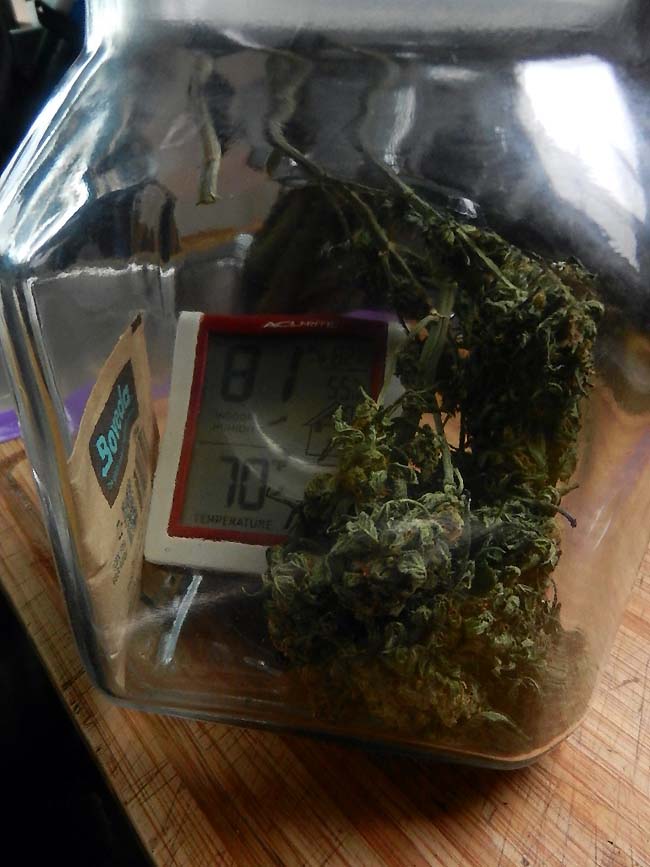
Today the combined weight of the plants reached the target weight of 23
grams after 4 full days of drying. They were transferred to a large sealed
glass jar containing a
62% RH Boveda Pack and a combined temperature/relative
humidity gage to keep track of the two most important variables in the drying
process.
At this stage it is critical to carefully control the final drop in moisture
content from 30% down to around 25%. Below that and the harvest is
compromised.
Using the sealed glass jar and the Boveda pack provides the control needed
as the pack will absorb any moisture in excess of 62% and will restore that
moisture if the RH in the jar drops below 62%.
It had been determined that cannabis, like tobacco, needs to maintain some
moisture to retain flavor and potency and the humidity packs insures that
the target range (57- 62% RH) is achieved.
The pack will be removed after 3 -5 days or when the humidity remains stable over a 24 hour period.
At
that point the buds will be removed from the stems and given their final
trim and stored in a smaller jar. Any remaining excess moisture will be allowed
to dissipate by a daily airing of that jar for another 10 days. Initially
the gage reflected the room temperature and humidity (70/81RH) but after
24 hours it will display the actual RH within the jar.
Day 5 (7-7):
This
morning the combined weight was still at 23 grams. By late afternoon (5 full
days of drying) it had dropped to 22 grams or 29% of the harvest weight.
Day 6 (7-8):
22 grams in the morning. In the late afternoon (6 full days of drying) it was 21 grams or 28%.
Day 7 (7-9):
21 grams in the morning. By late afternoon (7 full days of drying) it was 20 grams or 26%.

Did the final manicure late this afternoon ... 12 grams of finely trimmed
buds and 3 grams of sugar leaf for a total of just over 1/2 ounce. A sample
bud ground easily and smoked smoothly without any harshness leaving mostly
white ash. Very little aroma although the trimming shears did have to be
cleaned of accumulated resin.
This will need to be cured for a minimum of 10 additional days to bring out what little flavor it has. The
odor is somewhat 'skunky' and the effect is that of an indica ... heavy lidded
and drowsy but some of that comes from the unconverted THCA which will become
THC as it cures.
(Week 9)

This
picture was taken on 7-2 just before the front row was harvested leaving room for some of the plants in the
vegetation chamber to be brought in during the day to benefit from the more
powerful LED light.
7-5:
The three remaining plants were given 1 cup of RO H
2O each bringing the wet
weight of the containers to approximately 1250 grams.
7-9: The plants were given 1 cup each of RO H
2O with a heavy (2 tbs. p/gal)
feeding of the organic fertilizer BioThrive Bloom bringing the wet weight
of the containers to approximately 1250 grams.
7-10:
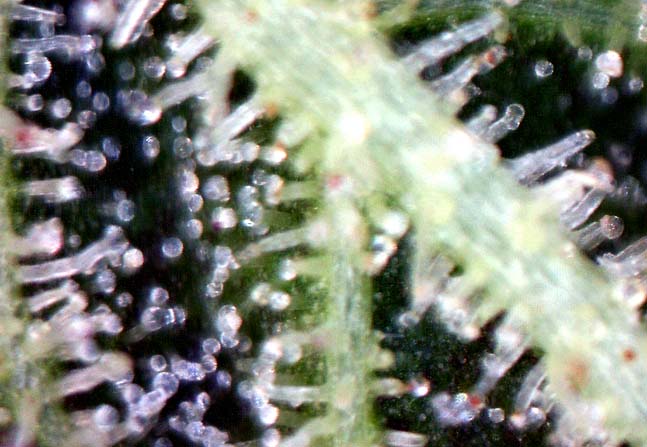
Trichomes Day 63 Plant 11
Trichomes are fully developed with most stalks filling with resin and turning
cloudy. The plants will be ready to harvest in another week.
(Week 10)

One more week and this grow will be complete ... my first grow from seed.
7-12: The plants were given 1 cup each of RO H
2O with a heavy (2 tbs. p/gal)
feeding of the organic fertilizer BioThrive Bloom bringing the wet weight
of the containers to approximately 1200 grams. This will be the last feeding
before the 7-17 harvest.
7-16:
The last three Mystery plants (front row) were each given 1 cup of RO H
2O
bringing the wet weight of their containers to 1200 grams. The multi-lobed
fan leaves were removed to allow the interior and side buds to dry out a bit
prior to tomorrow's harvest to avoid mold. These trimmings were added to
those from the first harvest for a total of 30 grams. Trimmings aren't smokeable
but do contain a small percentage of cannabinoids and can be used to make
concentrates like CannaButter for adding to baked goods.
The middle row contains 2 Berry Kush plants and another from the legendary strain
Pineapple Express. The rear row has a Mystery strain mother plant and four
of the Mystery Skunk strain seedlings.
When the second set of plants are harvested the photoperiod will be adjusted
to 18/6 and all of the plants in the current vegetation chamber will be transferred
over. They will all vegetate to at least 12" tall before the lights are flipped
back and they are forced into flower. There will be a total of 12 such plants
and I am hoping that, when sexed, at least 6 will be female.
July 17th: Day 70
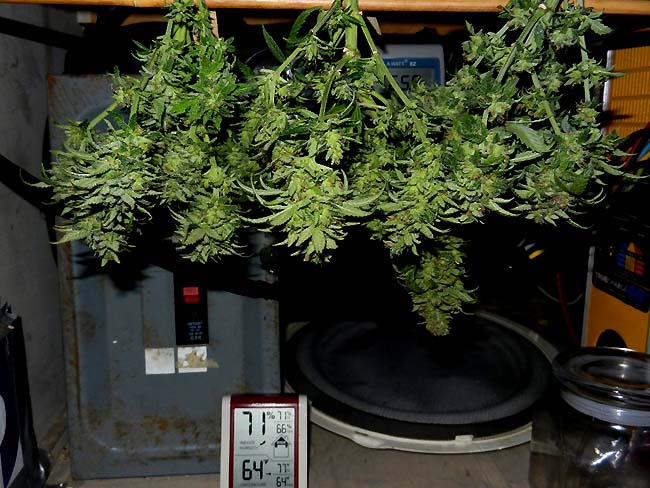
Final Harvest Plants #1,5,11
Harvested
the remaining three plants this morning just before the light came on ...
the unwanted starches and sugars remain in the roots and don't return to
the above ground vegetation until stimulated by light. The total weight was
84 grams of rough trim stalks.
The multi-lobed fan leaves had been removed
but the single blade sugar leaf was retained to keep the buds from drying
out too fast. After drying down to 25% of the wet weight the resulting yield
should be around 21 grams. The final trim will reduce that amount to just
about 1/2 ounce (14 grams).
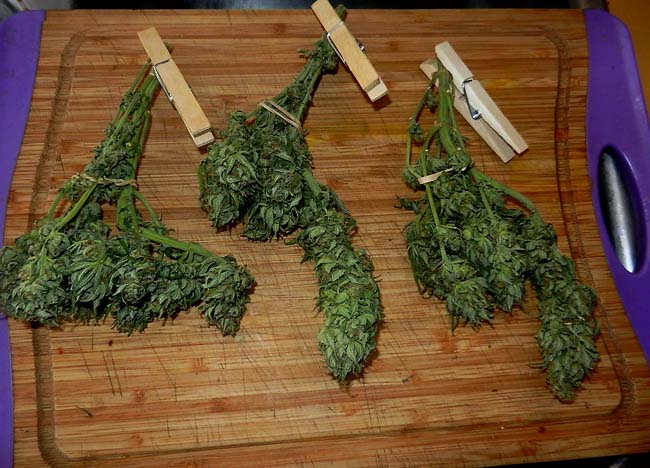 Drying Log
Drying Log
Plants #1,5,11
(Grampy's Memorial)
7-17-15
My
brother died July 15th two days before these plants were harvested. He had
visited Namaste Gardens during his terminal illness and had discussed medical
marijuana. These buds are for him. They will be held as a private reserve
to be shared with family and friends in his honor. RIP.
Day 1 (7-18)
:
44 grams or 52% of their original wet weight of 84 grams after the
first full 24 hours of drying. The stalks and branches have been loosely
bundled together with rubber bands to slow down the evaporation. They have
already developed a slight 'skunky' smell. A small container of water was
placed in the drying cabinet as the relative humidity had dropped to 50%
by late afternoon.
I've discovered the easiest way to hang the drying plants on the bamboo rack
is to clamp a clothespin on the stalk at a 45 degree angle making a hook.
Day 2 (7-19): 30 grams or 36%. Yesterday the humidity ranged from 76% to 40% overnight. The temperature ranged from 81F to 59F.
Day 3 (7-20): 25 grams or 30%. Yesterday the humidity ranged from 82% to 46% overnight. The temperature ranged from 90F to 70F.
At this stage it is critical to carefully control
the final drop in
moisture content from 30% down to around 25%. Below that and the harvest
is compromised. Accordingly the colas were transferred to a large sealed glass jar containing a
62% RH Boveda Pack and a combined temperature/relative humidity gage to keep
track of the two most important variables in the drying process.
Day 4 (7-21): 24 grams or 28%.
Day 5
(7-22): At 5 pm this afternoon the
scale was still showing 24 grams even after the Boveda Pack had been removed
for several hours. Today the relative humidity ranged from 62 - 81% with
temperatures in the 70s. The lid will be left off the jar to speed
up the drying a bit.
Day 6 (7-23): 23 grams or 27%. Still 23 grams at 5 pm when the colas were removed from the jar and re-hung on the bamboo rack.
Day 7 (7-24): 23
grams still at 6 am this morning. Since the drying process has stabilized
the buds can now be trimmed and jarred without too much concern over the
possibility of mold.
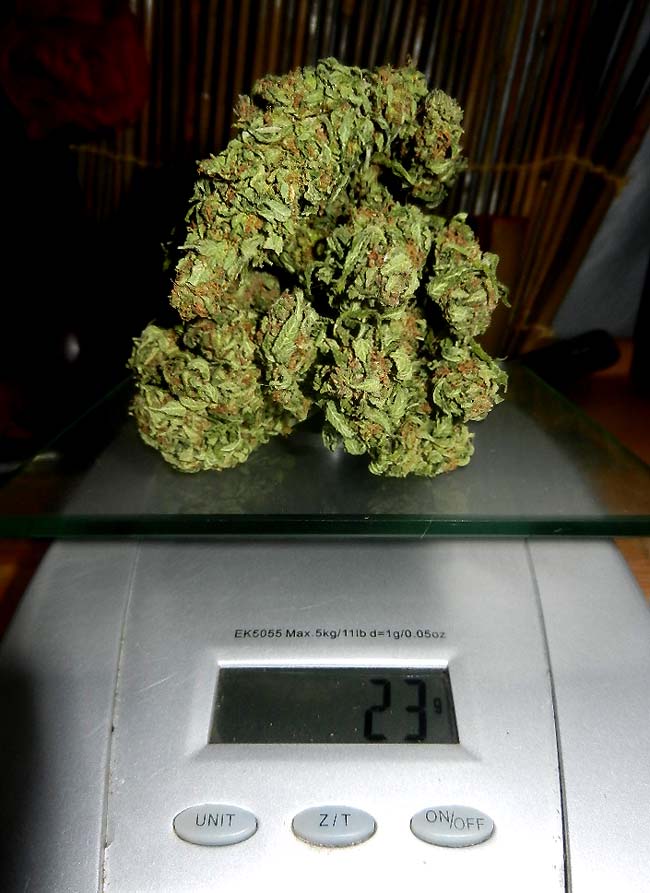
Did the final trim this morning separating bud from stalk and then manicuring
each bud by removing enough sugar leaf to reveal the dry brown pistils and calyxes underneath. Although
the sugar leaf (small overlapping leaves above) is smokeable it has a lower level of cannabinoids and leaving
it on the dried bud dilutes the overall potency.
The sugar leaf and the shake (multi-lobed leaves removed previously) though
are ideal for use in concentrates such as kief or hashish. Those are produced
by grinding and sifting the buds to collect the trichomes (resin glands) removing
80-90% of the associated vegetable material in the process. Similar to crushing
and straining grapes for their juice.
Totals: 13 grams manicured bud; 3 grams sugar leaf.
Overall: 25 grams of manicured bud, 6 grams of sugar leaf and 18 grams of shake.
Transferred the buds to a small 4 oz. mason jar to be
cured. Over the next 10 days the buds will slowly exhaust additional moisture.
The jar will be opened daily to allow the accumulated moisture and gasses
to vent.
Sativa or Indica?
These were called the Mystery plants because
they were grown from seed of an unknown origin. What I have subsequently
observed is that they were obviously a hybrid due to their short stature
- pure sativas would be tall and gangly. However, as the above image
indicates, this is apparently a sativa dominant hybrid as expressed in their
long and narrow terminal (top) colas. The tops from Indicas are as wide as they are tall - like fat gum balls.
Back to Top